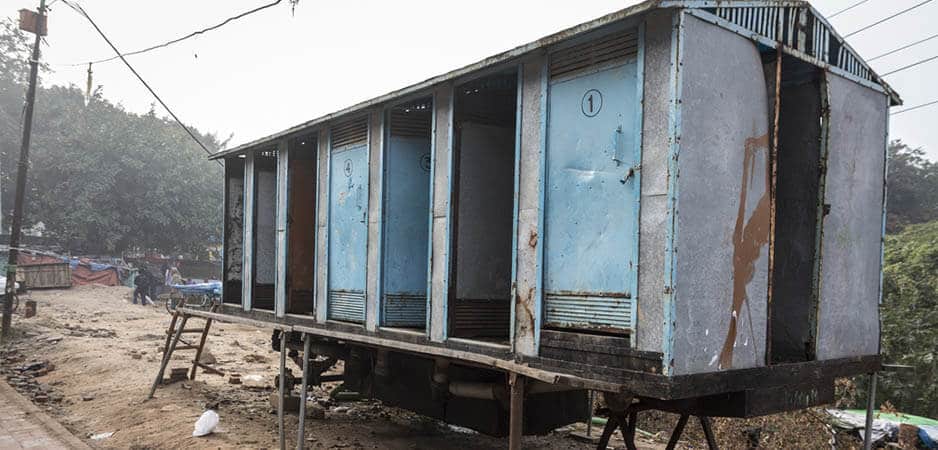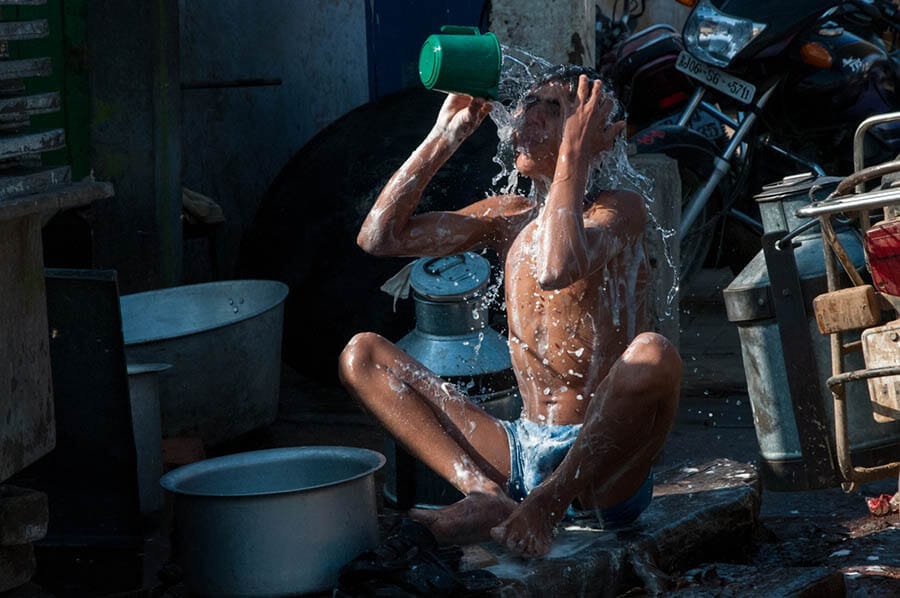More than constructing toilets, India needs to change the way its people think, behave and act when it comes to personal and public hygiene. This is the second of a three-part series.
Indians have some of the most elaborate cleaning rituals in the world. It has roots in a peculiarly Indian sense of hygiene. At the same time, public hygiene remains a challenge, which in turns affects public health. This curious contradiction is unique to India. It deserves deep examination and rigorous analysis.
POST-TOILET PROCESSES
The previous article in this three-part series examined how the Indian psyche obsesses with purity and pollution. Indians not only obsess with the right way to clean their bottoms, but also what to do after defecation.
Since the process of cleaning one’s bottom is deemed polluting, a number of questions arise. What does one do immediately afterwards? Which hand should one use for wearing pants, pajamas or shorts? Should one wash both hands, especially, the polluted left hand before touching clothes?
For more affluent Indians who have used bathrooms and toilets with handwashing facilities, the last question might not be pertinent. However, this question certainly applies to low-income households as well as semi-urban and poorer areas. In such settings, it is common to have a washbasin or hand-pump outside the toilet. So, people do not have the option to pull up their pants or shorts after washing their hands.
However, what happens when the handwashing options exist? What do Indians generally do? What should they do? We do not really have empirical data on toilet practices and the variations across regions, class or caste, but two examples gives us deep insights.
This author has seen many different types of toilets across India over the years. In one rather prosperous village in the state of Bihar, this author came across a type of toilet that is common in rural areas. It was in one corner of a closed courtyard. The house did not have piped water supply from a municipal authority. It had a hand-pump at the back of the house. The toilet measured 3×3 feet with its ceiling at 6 feet. Indian toilets can often have low ceilings because people squat instead of sit while defecating. Interestingly, the bathroom for performing ablutions was in the other corner.
This house might not have piped water coming to the property, but it had a small water tank on the roof, an electric motor and a water pump. This meant that both the toilet and the bathroom had piped water coming in from the water tank. The tiny toilet had a soap for people to wash their hands. This meant that people could wear their lower garments with clean hands.
In contrast, another rural household in the same state of Bihar did not have a soap in a similarly small toilet. People washed their hands after coming out of the toilet. This meant they pulled up their lower garments with polluted hands.
A simple question arises: Why did two tiny toilets with barely enough headroom to stand have two different practices? Could the answer be caste? One toilet was from a forward-caste household, while the other was from a backward-caste household. A sample size of two is not enough to make a generalization. However, the very basis of caste lies in the purity and impurity of birth. Therefore, it is quite possible that caste might have a major bearing on differential toilet practices and deserves deeper examination.
CLEANLINESS BEYOND BOTTOM CLEANING
Western and Indian practices differ not only when it comes to bottom cleaning, but also to cleaning up after vomiting. In the West, most people vomit in the commode. In India, no self-respecting member of the middle class would do so. The commode is where people defecate or urinate. It is impure. Therefore, Indians vomit in the wash basin.
Westerners seem to believe that dirty or unhygienic materials can come out not only from anal, urinary or genital orifices, but also oral and nasal ones. They are all treated similarly. Therefore, they can all be discharged in the same place — i.e., the commode. Indians view anything coming out of anal, urinary or genital orifices as impure and polluting. In contrast, anything coming out of the oral or nasal orifices is not quite impure or polluting. However, taking one’s face close to the commode might have a polluting effect and has to be scrupulously avoided.
 Even touching the commode can be polluting. For centuries, those who cleaned toilets and handled excreta were deemed untouchables. In recent years, the veneer of economic development and urbanization may hide the hold of caste in India, but it reveals itself in the idea of the impurity of defecation, urination, menstruation, latrines and commodes.
Even touching the commode can be polluting. For centuries, those who cleaned toilets and handled excreta were deemed untouchables. In recent years, the veneer of economic development and urbanization may hide the hold of caste in India, but it reveals itself in the idea of the impurity of defecation, urination, menstruation, latrines and commodes.
The best illustration of how Indians treat body parts differently can be seen in their bathing process. When bathing, either using a shower or by pouring water using a mug from a bucket, many Indians clean their anal and genital regions first with soap and water. Often armpits will also get the same treatment. And after Indians have cleaned these polluted body parts, they will wash the soap and then use it to clean rest of their unpolluted body.
HOW DO WE EXPLAIN DEFECATION IN THE OPEN?
The post-defecation dilemmas of tiny toilets do not apply when people defecated in the open. In 2014, the BBC estimated this number to be as high as 48%. Those who are poor and generally belong neither to the middle class or the forward castes do not have the luxury to think about the transmission of impurity from polluted hands to their lower garments. They simply do not have the option of washing their hands with soap before putting on their clothes again.
From a purely hygienic view, we can certainly argue that washing hands with soap before putting on lower garments is a good idea. Yet the focus on this benefit is marginal given the scale of dirty toilets, poor sanitation and open defecation in India. Sadly, the Indian mind focuses on cleaning the private space and neglecting public space.
One of the first things foreigners notice when they come to India is the mountain of trash that blights roadsides, villages, small towns and cities. The same people who might religiously clean their bottoms and wash their hands with soap before wearing lower garments often have no compunction throwing used water bottles by the roadside or dumping their trash right outside their home. Pollution is forced out of the private spaces of homes into the public spaces of streets, parks, ponds and rivers on a daily basis.
SWACHH BHARAT: THE CHALLENGE OF CLEANING INDIA
It turns out that widely-held beliefs of purity and pollution have important social ramifications. Hygiene and health are public goods with huge externalities. Therefore, the government is forced to make policy interventions. After all, a cleaner country leads to better health and less disease apart from improved optics.
However, policymakers rarely tend to take deep-seated Indian beliefs into account. This makes many policies and programs ineffective. This is a challenge that Prime Minister Narendra Modi’s Swachh Bharat program to clean the nation is currently encountering.
One of the policy goals of the government is to make open defecation an act of the past. Yet the challenge it faces is that Indians consider defecation and toilets impure. For centuries, people walked a fair bit to relieve themselves far away from home. So, many Indians would not like the toilet to be situated within their homes.
It has been easier to convince Indians to defecate in toilets instead of in the open, but harder to persuade them to build toilets in their homes. Therefore, we can see small toilets constructed outside homes as stand-alone structures in rural areas. Indians are often averse to using these toilets that are often pit-toilets because the smell, sight, touch and lack of water supply to these dingy 3×3-feet structures.
For women, there is the added element of shame. They do not want to be seen going into toilets. They are used to going for open defecation before sunrise or after sunset in the dark to preserve their modesty.
Diane Coffey and Dean Spears have examined this phenomenon in their insightful book, Where India Goes: Abandoned Toilets, Stunted Development and the Costs of Caste. They argue that the main hurdle to the elimination of open defecation in India is the notion of ritual purity. In rural India, 89% openly defecate and government-built latrines are often not used. In the words of Asif Dowla, rural “Indians, irrespective of income, class, and caste, don’t want to build and use latrines because they don’t want to empty the pit/tank once it is filled with human waste and they don’t want to live in proximity to human waste.”
The reality is that notions of purity and impurity are not limited to rural Indians. Urban Indians have them too. So, how is it that they have adopted toilets in their homes? Is it because they have flush-toilets instead of pit-toilets? Is it because flush toilets take their feces and urine far away from home? Is it because by taking these polluting materials away, they leave urban homes pure?
From a public policy perspective, the fact that millions of Indians are not used to washing their hands with soap after defecating in the open is a public health hazard. In older times, soaps were not available easily. People used clay or soil to clean their hands. Today, that is no longer the case. India does not lack soap. The goal of getting Indians to wash their hands after defecation has to be a policy goal regardless of whether they do so before or after putting on their lower garments.
The current singular policy focus to construct toilets in rural India might be unwise. Perhaps it is more important to change people’s behavior. And that is only possible when deeply-held social and cultural beliefs of purity and pollution are challenged. It involves changes to the way we think as a people and to our stratified social structure where class and caste act as deep divides. Changing the way Indians think, behave and act is the big challenge not only for the government, but also everyone interested in improving the nation’s health.
The views expressed in this article are the author’s own and do not necessarily reflect Fair Observer’s editorial policy.
Support Fair Observer
We rely on your support for our independence, diversity and quality.
For more than 10 years, Fair Observer has been free, fair and independent. No billionaire owns us, no advertisers control us. We are a reader-supported nonprofit. Unlike many other publications, we keep our content free for readers regardless of where they live or whether they can afford to pay. We have no paywalls and no ads.
In the post-truth era of fake news, echo chambers and filter bubbles, we publish a plurality of perspectives from around the world. Anyone can publish with us, but everyone goes through a rigorous editorial process. So, you get fact-checked, well-reasoned content instead of noise.
We publish 2,500+ voices from 90+ countries. We also conduct education and training programs
on subjects ranging from digital media and journalism to writing and critical thinking. This
doesn’t come cheap. Servers, editors, trainers and web developers cost
money.
Please consider supporting us on a regular basis as a recurring donor or a
sustaining member.
Will you support FO’s journalism?
We rely on your support for our independence, diversity and quality.







